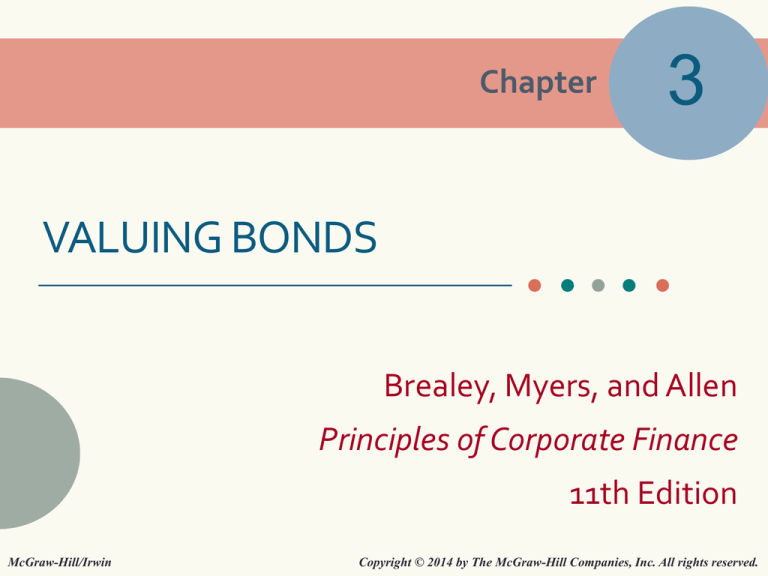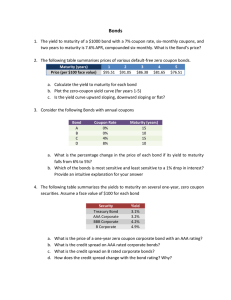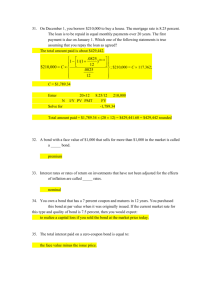
Chapter
3
VALUING BONDS
Brealey, Myers, and Allen
Principles of Corporate Finance
11th Edition
McGraw-Hill/Irwin
Copyright © 2014 by The McGraw-Hill Companies, Inc. All rights reserved.
3-1 USING THE PRESENT VALUE FORMULA TO
VALUE BONDS
1,000 C N
C1
C2
PV
...
1
2
N
(1 r ) (1 r )
(1 r )
3-2
3-1 USING THE PRESENT VALUE FORMULA TO
VALUE BONDS
• Example
• Today is October 1, 2010; what is the value of the
following bond? An IBM bond pays $115 every
September 30 for five years. In September 2015 it
pays an additional $1,000 and retires the bond. The
bond is rated AAA (WSJ AAA YTM is 7.5%).
115
115
115
115
1,115
PV
2
3
4
1.075 1.075 1.075 1.075 1.0755
$1,161.84
3-3
3-1 USING THE PRESENT VALUE FORMULA TO
VALUE BONDS
• Example: France
• In October 2011 you purchase 100 euros of
bonds in France which pay a 5% coupon every
year. If the bond matures in 2016 and the YTM
is 3.0%, what is the value of the bond?
5
5
5
5
105.0
PV
1.024 1.024 2 1.024 3 1.0244 1.0245
€112.11
3-4
3-1 USING THE PRESENT VALUE FORMULA TO
VALUE BONDS
• Another Example: Japan
• In July 2010 you purchase 200 yen of bonds in
Japan which pay an 8% coupon every year. If
the bond matures in 2015 and the YTM is
4.5%, what is the value of the bond?
16
16
16
16
216
PV
2
3
4
1.045 1.045
1.045 1.045 1.0455
¥243.57
3-5
3-1 USING THE PRESENT VALUE FORMULA TO
VALUE BONDS
• Example: USA
• In February 2012 you purchase a three-year
U.S. government bond. The bond has an annual
coupon rate of 11.25%, paid semiannually. If
investors demand a 0.085% semiannual return,
what is the price of the bond?
56.25
56.25
56.25
56.25
56.25
1056.25
1.00085 1.000852 1.000853 1.000854 1.000855 1.000856
$1,331.40
PV
3-6
3-2 HOW BOND PRICES VARY WITH INTEREST
RATES
• Example, Continued: USA
• Take the same three-year U.S. government
bond. If investors demand a 4.0% semiannual
return, what is the new price of the bond?
56
.
25
56
.
25
56
.
25
56
.
25
56
.
25
1056
.
25
PV
5
2
3
4
6
1.04 1.04 1.04 1.04 1.04
1.04
$1203.05
3-7
FIGURE 3.1 INTEREST RATE ON 10-YEAR
TREASURIES
16
14
12
Yield, %
10
8
6
4
2
0
Year
3-8
3-2 HOW BOND PRICES VARY WITH INTEREST
RATES
115.00
110.00
Bond price
105.00
100.00
95.00
90.00
85.00
80.00
Interest rate, %
3-9
FIGURE 3.2 MATURITY AND PRICES
5000
4500
4000
When interest rate =
11.25% coupon, both
bonds sell for face
value
Bond price
3500
3000
2500
2000
1500
1000
500
0
0
2
4
6
8
10
12
14
16
18
20
22
24
26
28
Interest rate, %
3-10
3-2 HOW BOND PRICES VARY WITH INTEREST
RATES
1 PV(C1 ) 2 PV(C2 ) 3 PV(C3 )
T PV(CT )
Duration
...
PV
PV
PV
PV
duration
Modified duration volatility (%)
1 yield
3-11
3-2 DURATION CALCULATION
Year
Payment
Ct
PV(Ct) at
4.0%
Fraction of Total
Value
[PV(Ct)/V]
Year × fraction of
total value
[t × PV(Ct)/PV]
1
$90
$86.54
0.0666
0.0666
2
90
83.21
0.0640
0.1280
3
90
80.01
0.0615
0.1846
4
90
76.93
0.0592
0.2367
5
90
73.97
0.0569
0.2845
6
90
71.13
0.0547
0.3283
7
1090
828.31
0.6371
4.4598
PV =
$1300.10
Total = duration =
5.60
3-12
Bond price, %
3-2 DURATION & BOND PRICES
Interest rate, %
3-13
3-3 TERM STRUCTURE OF INTEREST RATES
• Short- and long-term rates are not always parallel
• September 1992–April 2000: U.S. short-term
rates rose sharply while long-term rates declined
3-14
3-3 TERM STRUCTURE OF INTEREST RATES
YTM (r)
1981
1987 & Normal
1976
1
5
10
20
30
Year
• Spot Rate: Actual interest rate today (t = 0)
• Forward Rate: Interest rate, fixed today, on future loan at
fixed time
• Future Rate: Spot rate expected in future
• Yield To Maturity (YTM): IRR on interest-bearing instrument
3-15
FIGURE 3.4 SPOT RATES ON U.S. TREASURY
STRIPS, 02/2012
3-16
3-3 LAW OF ONE PRICE
• All interest-bearing instruments priced to fit
term structure
• Accomplished by modifying asset price
• Modified price creates new yield, which fits
term structure
• New yield called yield to maturity (YTM)
3-17
3-3 YIELD TO MATURITY
• Example
• $1,000 Treasury bond expires in 5
years. Pays coupon rate of 10.5%.
What is YTM if market price is 107.88?
C0
C1
C2
C3
C4
C5
−1078.80
105
105
105
105
1105
Calculate IRR = 8.5%
3-18
3-4 TERM STRUCTURE
• Expectations Theory
• Term Structure and Capital Budgeting
• CF should be discounted using term
structure info
• When rate incorporates all forward
rates, use spot rate that equals project
term
• Take advantage of arbitrage
3-19
3-5 DEBT AND INTEREST RATES
• Classical Theory of Interest Rates
(Economics)
• Developed by Irving Fisher:
• Nominal Interest Rate = Actual rate paid when
borrowing money
• Real Interest Rate = Theoretical rate paid when
borrowing money; determined by supply and demand
r
Supply
Real r
Demand
$ Qty
3-20
2008
2004
2000
1996
1992
1988
1984
1980
1976
1972
1968
1964
1960
1956
1952
1948
1944
1940
1936
1932
1928
1924
1920
1916
1912
1908
1904
1900
Annual inflation, %
FIGURE 3.5 ANNUAL U.S. INFLATION RATES,
1900-2011
25
20
15
10
5
0
-5
-10
-15
3-21
Italy
Japan
Finland
France
Spain
Belgium
Germany ex
1922/23
South Africa
Average
Ireland
U.K.
Denmark
Australia
Norway
New Zealand
Sweden
Canada
U.S.
Netherlands
Switzerland
Average inflation, %
FIGURE 3.6 GLOBAL INFLATION RATES, 1900-2011
12
10
8
6
4
2
0
3-22
3-5 DEBT AND INTEREST RATES
• Nominal r = Real r + expected inflation
(approximation)
• Real r theoretically somewhat stable
• Inflation is a large variable
• Term structure of interest rates shows
cost of debt
3-23
3-5 DEBT AND INTEREST RATES
• Debt and Interest Formula:
1 rnominal (1 rreal) (1 i)
3-24
FIGURE 3.7 UK BOND YIELDS
14
12
10-year nominal interest rate
8
6
4
10-year real interest rate
2
Jan-08
Jan-06
Jan-04
Jan-02
Jan-00
Jan-98
Jan-96
Jan-94
Jan-92
Jan-90
Jan-88
Jan-86
0
Jan-84
Interest rate, %
10
3-25
FIGURE 3.8 GOVT. BILLS VS. INFLATION,
1953-2011
3-26
FIGURE 3.8 GOVT. BILLS VS. INFLATION,
1953-2011
3-27
FIGURE 3.8 GOVT. BILLS VS. INFLATION,
1953-2011
3-28
3-6 THE RISK OF DEFAULT
• Corporate Bonds and Default Risk
• Payments promised to bondholders
represent best-case scenario
• Most bonds’ safety judged by bond ratings
3-29
TABLE 3.6 PRICES AND YIELDS OF CORPORATE
BONDS, 01/2011
Price, % of
S&P Rating Face Value
Yield to
Maturity
Issuer
Coupon
Maturity
Johnson &
Johnson
5.15%
2017
AAA
122.88%
1.27%
Walmart
5.38
2017
AA
117.99
1.74
Walt Disney
5.88
2017
A
121.00
2.07
Suntrust Banks
7.13
2017
BBB
109.76
4.04
U.S. Steel
American
Stores
Caesars
Entertainment
6.05
2017
BB
97.80
6.54
7.90
2017
B
97.50
8.49
5.75
2017
CCC
41.95
25.70
3-30
TABLE 3.7 BOND RATINGS
Moody's
Standard & Poor's
and Fitch
Investment grade bonds
Aaa
Aa
A
Baa
AAA
AA
A
BBB
Junk bonds
Ba
B
Caa
Ca
C
BB
B
CCC
CC
C
3-31
3-6 THE RISK OF DEFAULT
• Sovereign Bonds and Default Risk
• Sovereign debt is generally less risky than
corporate debt
• Inflationary policies can reduce real value
of debts
3-32
3-6 THE RISK OF DEFAULT
• Sovereign Bonds and Default Risk
• Foreign Currency Debt
• Default occurs when foreign government
borrows dollars
• If crisis occurs, governments may run out of
taxing capacity and default
• Affects bond prices, yield to maturity
3-33
3-6 THE RISK OF DEFAULT
• Sovereign Bonds and Default Risk
• Own Currency Debt
• Less risky than foreign currency debt
• Governments can print money to repay bonds
3-34
3-6 THE RISK OF DEFAULT
• Sovereign Bonds and Default Risk
• Eurozone Debt
• Can’t print money to service domestic debts
• Money supply controlled by European Central
Bank
3-35









